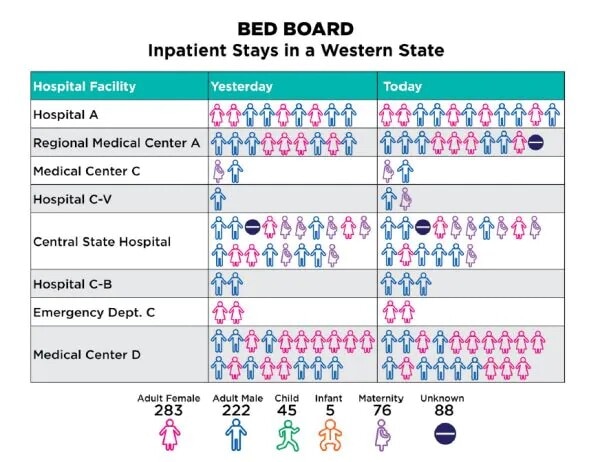
CUSTOMER: Major U.S.-Based Health Plan
CHALLENGE: Deliver complete visibility, in real time, into which health plan members are in an emergency room or admitted to a hospital
OUTCOME: A real-time dashboard application completed in under 30 days, augmented with machine learning capabilities, reducing clinical review costs by 20%
The Chief Medical Officer at a major west-coast health plan in the U.S. asked for complete visibility into who’s in the hospital at any given moment. Given the work the health plan was already doing with InterSystems and health information exchange, the director of corporate data and analytics answered confidently, “Yes, we can do that.” “Can you do it in six months?” the CMO asked. The reply? Also affirmative.
The result, created in under 30 days, was the health plan’s “Bed Board” application, an answer to some common challenges among health insurers.
The health plan insures 2 million people in several western states. Every day, it receives faxes, emails, and phone calls from multiple hospitals and, from them, compiles a daily “census” of which members are receiving emergency or inpatient care, and their locations. The goal is to use this information to:
- Review and prioritize cases for medical management and follow up
- Ensure delivery of optimal care
- Avoid the costs of unnecessary tests, treatments, hospitalizations, or inappropriate care
The health plan has 24 hours after an admission to make determinations on issues like medical necessity or appropriateness of treatment if it’s going to intervene. The old way – looking across different pieces of paper to synthesize all the data – was a slow and inefficient process. By the time actionable information got to the right people it often was too late to influence the care delivered. The Bed Board application turned this around completely.
Real-Time Dashboard with Machine Learning Insights
Bed Board is a dashboard application enhanced with machine-learning insights. It gives clinical and business teams real-time visibility into the status of health plan members in acute care settings.
InterSystems HealthShare software was key to the success of Bed Board as it enabled the health plan to:
- Make connections and automatically aggregate the data from multiple external data feeds
- Uniquely identify each plan member in the incoming data
- Integrate the incoming electronic health record information with the plan’s claims data
- Normalize all of the data for use in downstream analytics and reporting
- Feed clean data to the plan’s machine learning algorithms and to data visualization tools such as Tableau
- Present supporting data whenever a user drills-down into Bed Board’s top-level, interactive display
Typically, aggregating and normalizing all the data in real-time feeds is the most time-consuming step in creating this type of solution. With HealthShare, this work was completed in less than a month.
Increasing Efficiency
Now, when a plan member registers in an emergency department or is admitted to a hospital, Bed Board is updated within one minute. HealthShare identifies the member across the incoming electronic health record data and existing claims data, and places member-level information in work queues to support clinical review activity. With each new event – a doctor is assigned, a preliminary diagnosis is established, or a patient is admitted – HealthShare updates Bed Board.
The increased efficiency of having all the information in one place, and the ability to drill down into the dashboard to get details about each patient, enables the plan’s Clinical Division to complete reviews within its 24-hour goal.
Bed Board also correlates admission volumes and patterns across the plan’s geographies with member demographics, diagnoses, and locations of care. The Clinical Division uses this information to monitor broader trends of utilization across covered regions.

Increasing Return on Investment by 20%
With an aggregated, normalized, and continuously updated data store in HealthShare, the health plan had the foundation for adding machine learning capabilities to the Bed Board application. Now, Bed Board doesn’t just gather the data for its users, it applies intelligence to it to reduce user workloads. The machine learning layer guides review teams on where to focus their attention for maximum impact.
In some cases, the machine learning algorithms can complete clinical review of admissions without involving a clinician. Previously, twenty percent of the admissions reviewed were for members who clearly needed to be in the hospital. Bed Board avoids clinician involvement in these cases, saving time and essentially reducing administrative costs for clinical review by 20%.
Getting a Grip on Real-Time Data Yields Greater Control
The plan’s Bed Board application demonstrates the value of combining machine learning with a longitudinal, real-time record of care. Visibility into real-time data and being able to ask questions about what is going on is a game changer. It allowed the Plan to understand the day-to-day workflow and know when something, in a particular facility or region, is getting out of control.




































